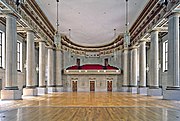Andrew W. Mellon Auditorium
Arthur Brown, Jr. | |
| Website | |
|---|---|
| eventsatmellon | |
Andrew W. Mellon Auditorium | |
| Architectural style | Classical Revival |
| Part of | Pennsylvania Avenue National Historic Site (ID66000865[1]) |
The Andrew W. Mellon Auditorium (originally named the Departmental Auditorium) is a 750-seat[2] historic Neoclassical auditorium located at 1301 Constitution Avenue NW in Washington, D.C. The auditorium, which connects two wings of the William Jefferson Clinton Federal Building, is owned by the U.S. government but available for use by the public.
Description

Colonnades link the auditorium to the buildings to the east and west, and galleries in the Auditorium's rear provide interior passages to these buildings as well. The galleries have received much praise. One critic noted, "The open galleries linking the auditorium to its neighbors constitute one of the greatest passages in American architecture."[11]
The entire structure has been called "one of the most magnificent auditoriums in the country."[12]
Construction
The building was constructed as part of the Federal Triangle development.[3][5] Although plans to redevelop the slum Murder Bay had existed for decades, Congress did not fund the purchase of land or construction of buildings in the area until 1926.[3][5] In July 1926, the government proposed building a Department of Labor Building between 13th and 14th Streets NW on the north side of B Street NW (now Constitution Avenue NW).[13] In March 1927, the government proposed adding a second building to the east (between 12th and 13th Streets NW) for "Independent Offices" (the building's purpose was later changed to be the headquarters of the Interstate Commerce Commission, or ICC).[14] Design work proceeded slowly.[3][5] In April 1930, President Herbert Hoover proposed building a $2 million "Departmental Auditorium" to connect the Labor and ICC buildings.[15]
President Hoover laid the cornerstones for the Labor/ICC building on December 15, 1932.
The Labor/ICC building and Departmental Auditorium were dedicated on February 25, 1935.[17] Secretary of Labor Frances Perkins dedicated the $4.5 million Labor building at a ceremony attended by AFL President Green.[17][18] The ICC portion of the structure cost $4.45 million.[19] The dedications occurred in the Auditorium, and constituted the first event ever held there.[20]
History
Several important events in American and world history have occurred in the Mellon Auditorium. President Franklin D. Roosevelt announced the re-institution of conscription in 1940 from the Auditorium stage.[21] The signing of the North Atlantic Treaty that established NATO occurred in the Auditorium on April 4, 1949.[22] President Bill Clinton signed the North American Free Trade Agreement there in 1994.[23] The 9/11 Commission released its findings in the Auditorium in 2004.[24] Much of the 2020 Republican National Convention took place in the Auditorium.[25]
The
The Mellon Auditorium was listed in the National Register of Historic Places as a contributing property to the Pennsylvania Avenue National Historic Site in 1966.[20] It was renovated and restored in 2000.[30]
Gallery
-
Front entrance on Constitution Avenue Looking NW
-
Lantern on the façade
-
Looking at a side doorway and reception room
-
Looking at the stage and auditorium from the rear balcony
-
Looking at the entrance to the auditorium from the stage
-
Looking up at the decorated ceiling at the side of the auditorium
-
The North Atlantic Council convening in the Mellon Auditorium in 1999
References
- ^ "National Register Information System". National Register of Historic Places. National Park Service. April 15, 2008.
- ^ "AWMA Capacities". Andrew W. Mellon Auditorium. Archived from the original on 2011-09-03. Retrieved 2011-09-06.
- ^ ISBN 0-8018-8328-8
- ^ ISBN 0-394-74875-1
- ^ ISBN 0-8018-8318-0
- ^ ISBN 0-87474-138-6
- ISBN 0-06-095368-3
- ISBN 0-06-277039-X
- ISBN 1-56098-161-X
- ^ Look, David W. and Perrault, Carole L. The Interior Building: Its Architecture and Its Ar. Washington, D.C.: National Park Service, 1986.
- ^ Wilson, Richard Guy. "Arthur Brown, Jr., California Classicist." Progressive architecture. December 1983.
- ISBN 0-87474-138-6
- ^ "4 Sites Selected for U.S. Buildings in Local Program." Washington Post. July 8, 1926.
- ^ Whitaker, Charles B. "Building for the Glory of Washington." New York Times. March 6, 1927.
- ^ "Hoover Urges Funds For Six New Buildings." Washington Post. April 23, 1930.
- ^ a b c d "Hoover Lays Stone of Labor Building." New York Times. December 16, 1932.
- ^ a b "Capital Dedicates New Labor Edifice." New York Times. February 26, 1935.
- ^ "Work On New I.C.C. Structure Nearing." Washington Post. April 21, 1931; "Firm Here Enters Low Bid on Razing." Washington Post. May 21, 1931.
- ^ "Capitol Triangle At Last Completed." Associated Press. August 4, 1935.
- ^ a b Wheeler, Linda. "A Gilded Setting for a Golden Summit." Washington Post. April 23, 1999.
- ^ "Stimson Will Draw First Number In Draft Lottery at Noon Oct. 29." New York Times. October 22, 1940.
- ^ "Russians May See Signing Of the Pact if They Wish." New York Times. April 1, 1949; Lawrence, W.H. "12 Powers Charge Russians Distort Defensive Treaty." New York Times. April 3, 1949; "Acheson Sees Pact As Bolstering U.N." New York Times. April 3, 1949; "Dedication for Peace." New York Times. April 5, 1949; Apple, R.W. "How the Midwives of NATO Prevailed." New York Times. April 23, 1999.
- ISBN 0-520-23178-3
- ISBN 0-8135-3799-1
- ^ Kilgore, Ed (August 14, 2020). "Most Republican Convention Speeches Will Be Delivered From D.C." Intelligencer.
- ^ "Environmental Protection Agency, Wast Building, Washington, DC". Real Estate / Explore Historic Buildings. U.S. General Services Administration. Retrieved 2017-07-10.
- ^ Volcovici, Valerie (2013-07-17). "EPA renames headquarters after former President Clinton". Reuters.
- ^ Sec. 9, Pub. L. 100-113, August 21, 1987; 101 Stat. 746. Archived January 6, 2010, at the Wayback Machine
- ISBN 0-307-38679-1
- ISBN 0-8018-8468-3







